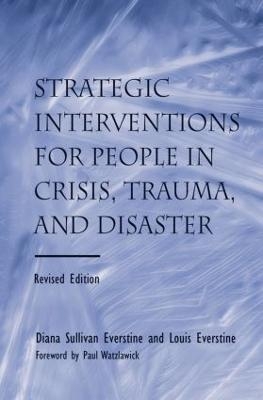
Strategic Interventions for People in Crisis, Trauma, and Disaster
Routledge (Verlag)
978-0-415-86113-7 (ISBN)
With the stressful turbulence of our present culture, more and more clinicians are called upon to intervene in crisis situations. Violent interactions, once considered rare or beyond the province of the therapist, have become familiar events to many practitioners. This volume provides them with both the theoretical background and practical techniques to help people learn from crisis experiences and move toward change and growth.
Of special interest are practical guidelines and specific intervention strategies for conducting psychotherapy with different types of violent persons and of victims. Treatment principles for each crisis situation are then illustrated in detailed case studies. As the authors demonstrate, with these troubled people a therapist must be ready to make quick decisions, draw upon all available resources from the family and community, and offer continuing support as traumas are worked through and new behavior patterns are learned. In addition, the authors discuss the legal and ethical responsibilities of the therapist.
Diana Sullivan Everstine, Ph.D., is Senior Research Fellow at the Mental Research Institute in Palo Alto, California, Director of Affiliated Psychologists & Counselors, Inc., Director of Behaviordata, Inc., an APA-approved CE provider. Louis Everstine, Ph.D., M.P.H., is Senior Research Fellow at the Mental Research Institute in Palo Alto, California, Director of Affiliated Psychologists & Counselors, Inc., Director of Behaviordata, Inc., an APA-approved CE provider.
Watzlawick, Foreword. Introduction. Acknowledgments. Emergency Psychology. The People. The Problem. The Center. Some Facts and Figures. Beyond the Model. Communication Principles for High Stress or Dangerous Situations. Clinical Intervention in Emergency Situations. The First Telephone Contact with a Person in Crisis. Responding to an Emergency. Arriving at the Scene of an Emergency Without the Police. Basic Steps and Goals. Strategies for Defusing Emergencies. Hospitalizing Persons in Crisis. Deciding Whether or Not to Hospitalize. Assessment and Plan. Involuntary Hospitalization. The Homicidal or Dangerous Person. A Case Study Illustrating the Hospitalization Process. A Case Illustrating that Things are Not Always What They Appear to Be. Domestic Violence. The Scope of the Problem. Couples who Fight Violently. A Violent Husband. A Case of Murder Reconsidered. Battered Spouses. A Battered Wife. The Battered Child. What is Child Abuse? General Diagnostic Indications. Physical Indications. Assessing the Safety of a Home. Treatment of Child Abuse. Sexual Assault on Children. The Child Victim. The Adolescent Victim. The Incestuous Family. Victims of Violent Crimes. General Characteristics of Victim Behavior. Victims of Prolonged Terror. The Adult Woman Victim of Rape. General Considerations. Treatment Techniques. Sexual Factors in Rape. The Criminal Justice Process. The Support Network. Suicide. Etiology of Suicidal Behavior. An Interactional View. Methods of Prevention. A Serious Attempt. Anatomy of a Suicide. Clinical Ethics and Legal Responsibilities. General Principles. Duty to Hospitalize. Duty to Warn. Duty to Report. Special Characteristics of Emergency Work. Index.
| Zusatzinfo | 1 Tables, black and white; 5 Illustrations, black and white |
|---|---|
| Verlagsort | London |
| Sprache | englisch |
| Maße | 152 x 229 mm |
| Gewicht | 453 g |
| Themenwelt | Medizin / Pharmazie ► Medizinische Fachgebiete ► Psychiatrie / Psychotherapie |
| ISBN-10 | 0-415-86113-6 / 0415861136 |
| ISBN-13 | 978-0-415-86113-7 / 9780415861137 |
| Zustand | Neuware |
| Haben Sie eine Frage zum Produkt? |
aus dem Bereich


